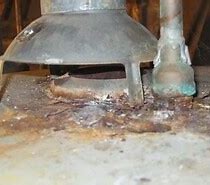New Jersey home inspectors should understand what back drafting is and how it can create a significant hazard in homes. What is back drafting? Back drafting is the reverse flow of toxic gas in fossil fuel operated equipment. Most of the fossil fuel operated equipment such as boilers, furnaces and water heaters use house air which makes them vulnerable to back drafting when air pressure in the home is low. Home inspectors in NJ should look for evidence of back drafting in homes that they are inspecting.
Fossil fuel fired boilers, furnaces and water heaters are made to vent combustion products to the exterior through a flue. The hot exhaust gas rise through the flue and exits the home because hot air rises, and they are not as dense as room temperature air. The pressure differential that allows for the exit of the hot exhaust gas can be negated by low indoor air pressure caused by the release of air to the exterior of the home by exhaust fans, fireplaces, dryers, whole house fans and other equipment. The release of toxic gas by back drafting has the potential to hurt and harm the occupants of the home. Also malfunctioning equipment, clogged or damaged flues or vents can also cause a back drafting problem.
NJ home inspectors can do the following to inspect for this unsafe back drafting condition.
A home inspector can hold a lighter beside the draft diverter to see if there is adequate draft to pull the lighter frame into the draft hood.
The home inspector can look for dark discoloration on the water heater, boiler or furnace under the area of the draft hood. The existence of soot or discoloration is an indicating of back drafting.
Home inspectors can use a carbon monoxide meter to determine if exhaust gases are entering the living space. Typically, some specialized training is required for the proper use and implementation of this type of metering.
A NJ home inspector can release smoke or powder into the draft hood to determine if it gets sucked into the duct or if it goes back into the room. A smoke pencil or chemical puffer can be used to simulate smoke.
This testing is typically outside the scope of a home inspection in New Jersey, but they are valuable in providing the client additional information and also for the safety of the client when they move into the home. Home inspectors should consider expanding their knowledge base and start performing this back drafting testing to provide a significant value-added service to their home inspection clients.
When doing the back drafting testing in the field. It is helpful if inspectors turn on all appliances that vent air into the outdoors in order to simulate worst-case conditions. Such devices may be dryers, whole house fans or bathroom and kitchen fans.
There are several types of equipment drafting that is helpful to understand.
Atmospheric drafting is the most common type of drafting associated with back drafting. Exhaust gases rise through the smoke pipe by the force of convection. Sometimes this convection is not strong enough to overcome the pull from the lowering of air pressure in the home caused by the use of fans or other appliances in the home.
Induced drafting incorporated a fan that creates the draft. the potential for back drafting is lowered because the fan unit is usually strong enough to overcome any competing pull from an indoor air pressure drop.
A sealed combustion and venting system are totally sealed off from the house sir. Combustion air is drawn in from the exterior through a piping system. The potential for back drafting is almost eliminated because the rate of ventilation in not influenced by the air pressure inside the home.
Home inspectors in New Jersey should educate their clients about the potential for toxic gas back drafting. Home inspectors should look for evidence of back drafting while performing home inspections.

